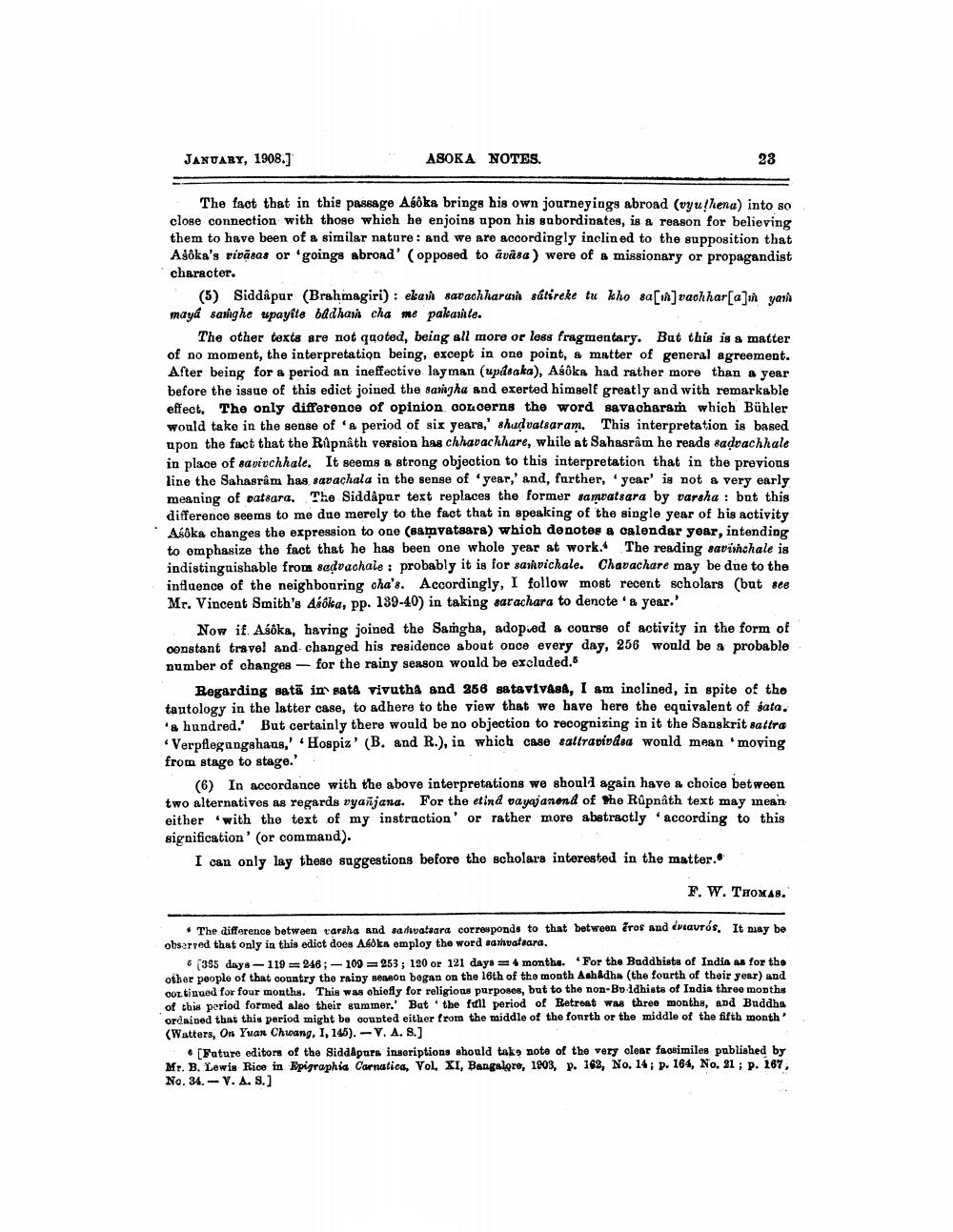________________
JANUARY, 1908.]
ASOKA NOTES
23
The fact that in this passage Aboka brings his own journeyings abroad (vyuthena) into so close connection with those which he enjoins upon his subordinates, is a reason for believing them to have been of a similar nature: and we are accordingly inclined to the supposition that Asoka's rivagas or 'goings abroad' (opposed to avāsa ) were of a missionary or propagandist character.
(5) Siddapur (Brahmagiri): ekav savachhara sátireke tu kho sa[1]vaoh har[a]ın yar mayd sanghe upayite badhani cha me pakanite.
The other texts are not quoted, being all more or less fragmentary. But this is a matter of no moment, the interpretation being, except in one point, a matter of general agreement. After being for a period an ineffective layman (updsaka), Asoka had rather more than a year before the issue of this edict joined the sarigha and exerted himself greatly and with remarkable effect. The only difference of opinion Concerns the word savacharam which Bühler would take in the sense of a period of six years,' shudvatsaram. This interpretation is based upon the fact that the Rupnâth version has chhacachhare, while at Sahasrâm he reads sadrachhale in place of savivchhale. It seems a strong objection to this interpretation that in the previous line the Sahasrâm has savachala in the sense of 'year,' and, further, 'year' is not a very early meaning of batsara. The Siddapur text replaces the former samvatsara by varsha : but this difference seems to me due merely to the fact that in speaking of the single year of his activity Asoka changes the expression to one (samvatsara) which denotes a calendar year, intending to emphasize the fact that he has been one whole year at work. The reading savinchale is indistinguishable from sadvachale : probably it is for sarkvichale. Chavachare may be due to the influence of the neighbouring cha's. Accordingly, I follow most recent scholars (but see Mr. Vincent Smith's Asoka, pp. 189-40) in taking sarachara to denote a year.'
Now if. Asoka, having joined the Samgha, adoped a course of activity in the form of constant travel and changed his residence about once every day, 256 would be a probable number of changes - for the rainy season would be excluded.
Regarding sată in Bata vivutha and 256 satavivase, I am inclined, in spite of the tautology in the latter case, to adhere to the view that we bave here the equivalent of sata. *a hundred. But certainly there would be no objection to recognizing in it the Sanskrit sattra * Verpflegungshaus,'Hospiz' (B. and R.), in which case saltradivdsa would mean moving from stage to stage.'.
(6) In accordance with the above interpretations we should again have a choice between two alternatives as regards vyañjana. For the etind vayajanond of the Rūpnath text may mean either with the text of my instruction' or rather more abstractly according to this signification' (or command). I can only lay these suggestions before the scholars interested in the matter.
F. W. THOMAS.
• The difference between taraha and sahwatsara corresponds to that between Tros aud (vautós. It may be observed that only in this edict does Aboka employ the word samvatsara.
6 (385 days - 119 = 246;-100 = 253 ; 190 or 121 days = 4 months. For the Buddhists of India as for the other people of that country the rainy season began on the 16th of the month AshAdha (the fourth of their year) and Qortinged for four months. This was ohiefly for religions purposes, but to the non-Bu idhists of India three months of this period formed also their summer. Bat the fall period of Retreat was three months, and Buddha ordained that this period might be counted either from the middle of the fonrth or the middle of the fifth month' (Watters, On Yuan Chuang, I, 145). - V. A. S.)
[Fature editors of the Siddhpurs insoriptions should take note of the very clear facsimiles published by M. B. Lewis Rice in Epigraphia Carnatics, Vol. XI, Bangalore, 1903, p. 162, No. 14; p. 164, No. 21; p. 167, No. 34. - V. A. S.]




